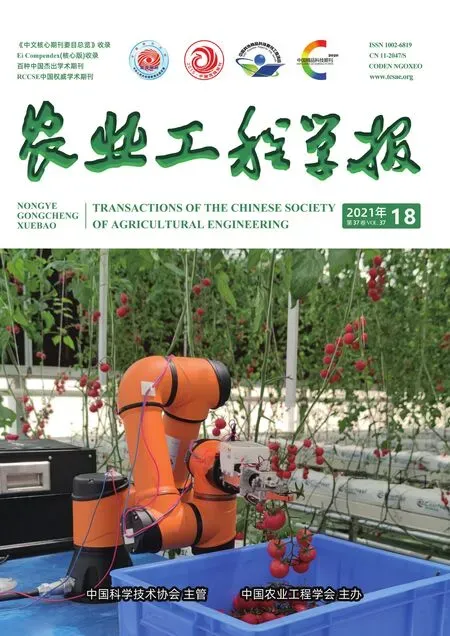花后渍水对不同耐渍型冬小麦籽粒灌浆特性的影响
吴启侠,谭京红,朱建强,王 威,韩 蕊,邹 娟
花后渍水对不同耐渍型冬小麦籽粒灌浆特性的影响
吴启侠1,2,谭京红1,2,朱建强1,2,王 威1,2,韩 蕊1,2,邹 娟3※
(1. 湿地生态与农业利用教育部工程研究中心,荆州 434025;2. 长江大学农学院,荆州 434025;3. 湖北省农业科学院粮食作物研究所,武汉 430064)
江汉平原冬小麦中后期常遭受涝渍灾害,为明确花后渍水对冬小麦籽粒灌浆进程的影响,以郑麦9023(耐渍型)和扬麦20(敏感型)2个小麦品种为研究对象,利用灌排可控的测坑模拟冬小麦花后不同天数(5、9、13和17 d)的渍水胁迫,应用Richards模型对冬小麦籽粒灌浆进程进行了模拟,在此基础上分析各籽粒灌浆参数与渍水天数的关系。结果表明:花后渍水5、9、13和17 d,郑麦9023(耐渍型)分别减产10.84%、19.51%、25.93%和36.52%,扬麦20(敏感型)分别减产14.25%、25.84%、37.26%和47.84%。导致冬小麦减产的主要原因是千粒质量降低,花后渍水天数每增加1 d,冬小麦郑麦9023和扬麦20千粒质量分别降低0.961和0.996 g。Richards方程能极显著模拟花后渍水冬小麦籽粒灌浆过程,拟合方程决定系数均在0.99以上。对耐渍型冬小麦,花后渍水主要显著缩短活跃灌浆期,且主要是显著缩短籽粒灌浆快增期和缓增期的持续天数;对敏感型冬小麦,花后渍水主要显著降低籽粒灌浆三阶段的灌浆速率。花后渍水增加1 d,郑麦9023籽粒活跃灌浆期缩短0.827 d,籽粒灌浆快增期、缓增期灌浆持续天数分别缩短0.492、0.963 d,扬麦20单粒最大灌浆速率降低0.046 mg/d、单粒平均灌浆速率降低0.032 mg/d,籽粒灌浆渐增期、快增期和缓增期单粒灌浆速率分别降低0.011、0.040和0.010 mg/d。研究可揭示花后渍水致使冬小麦减产的影响过程,为冬小麦涝渍灾害防控提供理论支撑。
灌溉;产量;渍水胁迫;Richards模型;灌浆特征参数;冬小麦
0 引 言
在中国,小麦是三大粮食作物之一,2019年种植面积占全国粮食作物播种面积的20.4%[1],在确保粮食安全上具有重要地位。长江中下游地区是中国冬小麦主产区之一,该区域冬小麦播种面积占全国小麦播种面积的20%左右[2]。该区域为季风气候,春季降雨量较多,且多集中于冬小麦生长中后期[3],加上多数实行水稻-冬小麦轮作种植方式[4],地势相对较低,土壤质地黏重,透水性差,导致长江中下游地区冬小麦中后期常遭受涝渍灾害威胁[5-6]。开花前后是冬小麦对渍水最敏感的时期[7-8],花后渍害使小麦地上部功能叶早衰,叶绿素合成受阻,光合作用受抑制,影响植株干物质的积累与转运,最终导致减产超过20%[9-10]。
单粒质量是小麦产量的重要构成因素[11],受作物品种[12]、降水[13]、土壤水分[14]等诸多因素影响。运用三次多项式方程、Logistic方程和Richards方程模拟作物灌浆过程,得出影响单粒质量变化的主要因素,是研究单粒质量变化的重要手段之一。Tian等[15]运用Logistic方程拟合了受渍春玉米灌浆过程;杨丽丽等[16]应用Richards方程对干旱胁迫后复水小麦强势粒、弱势粒的籽粒灌浆过程进行了拟合;徐云姬等[17]运用Richards方程对干湿交替灌溉水稻籽粒灌浆对籽粒灌浆过程进行了拟合。诸多学者围绕构建模型模拟水分变化影响作物籽粒灌浆过程进行了大量研究,但关于花后渍水条件下冬小麦籽粒灌浆过程的拟合分析研究报道甚少。花后渍水造成长江中下游地区冬小麦产量下降的主要原因是单粒质量减小[7],而单粒质量很大程度上取决于籽粒灌浆速率和持续时间[18],即具体灌浆过程。Richards生长模型可塑性强,拟合精度高,且能更好地反映品种的灌浆特性,并能够对灌浆期进行准确划分[19-20]。
为此,本研究利用灌排可控的测坑模拟不同耐渍型冬小麦花后渍水,运用Richards模型拟合冬小麦籽粒灌浆进程并分析产量构成要素,量化分析花后渍水对不同耐渍型冬小麦灌浆特性的差异化影响,揭示花后渍水致使冬小麦减产的影响过程,以期为冬小麦花后渍害精准调控提供理论支撑。
1 材料与方法
1.1 试验区概况
试验区为地处江汉平原腹地的长江大学试验基地(30°21′N,112°09′E),该基地属东部季风农业气候大区、北亚热带农业气候带、长江中下游农业气候区,试验期间气象要素如图1所示。试验在基地面积为4 m2(2 m×2 m)、深1 m的测坑中进行。测坑表面中部布设直径25 cm、长1.0 m的灌水管,灌水管连接灌水系统,灌水管均匀打孔,灌水时水以喷的形式灌到测坑中。测坑底部布设直径25 cm、长1.0 m的排水管,水管均匀打孔,排水管外有完善的反滤层,水管联通到测坑外后连接4个水阀,分别可排100、80、50和30 cm深地下水。测坑土层厚度为100 cm,土壤为中壤,取自旱地,按等土壤密度分层回填,0~30 cm耕层土壤pH值为7.6,土壤碱解氮含量为89.4 mg/kg,土壤速效磷含量为28.7 mg/kg,土壤速效钾含量为118.7 mg/kg。
1.2 试验设计
选择在江汉平原广泛栽培的2个小麦品种郑麦9023(耐渍型)和扬麦20(敏感型)作为供试材料[21]。播种前撒施养分含量N∶P2O5∶K2O为18∶8∶15的复合肥750 kg/hm2,施肥后混匀20 cm表层土壤,返青期撒施尿素125 kg/hm2。2017年11月6日播种,播种量为135 kg/hm2,采用条播方式,行距为25 cm,每测坑9行。
设5、9、13和17 d共4个花后渍水处理。2018年4月10日开始渍水,渍水处理为田间低洼处有明水,且土壤含水率保持在田间持水率的90%以上,达到设定渍涝时间后3 d将地下水位降到70 cm以下。以测坑内土壤水分保持在田间持水率的70%~80%(即大田正常水分管理要求的土壤水分含量)为对照(CK)。非渍涝时期将80 cm处水阀打开,遇降水时地下水从该水阀排出,维持非渍涝时期测坑地下水埋深为80 cm,与大田地下水埋深基本一致,其余管理同大田管理一致。各渍涝处理和对照均重复6次(3个测坑用于取样,3个测坑用于考种),采用随机区组试验设计。
1.3 采样方法
于冬小麦盛花期,每个取样测坑挑选开花日期相同、单穗大小基本一致的200单穗挂牌标记,标记时避开边行或有病虫害的单穗。花后5 d开始取样,以后每5 d取样1次,直至收获,每次每测坑取标记单穗10个,手工剥取籽粒,先统计籽粒粒数,再将籽粒置于烘箱中105 ℃杀青30 min,80 ℃烘干至恒质量,称量并折算千粒质量。
冬小麦成熟后,剔除受边际效应影响的植株,每测坑随机取生长基本一致的植株20株,按常规方法考察穗粒数、千粒质量、有效穗数。每测坑单独收获,晒干除杂后称取质量,作为每测坑的冬小麦籽粒实际产量。
1.4 数据处理
参照朱庆森等[22]方法用Richards方程对冬小麦籽粒灌浆进程进行拟合。Richards方程为
式中为开花后天数,d;为对应的籽粒千粒质量,g;为最终籽粒质量,g;为初级参数;为生长速率参数;为形状参数,反映灌浆库容限制情况,若0<<1,说明灌浆受库容限制较大,即灌浆物质来源相对充分;若>1,说明灌浆受库容限制较小,即灌浆物质来源相对匮乏[19]。当=1时为Logistic方程。
对Richards方程一阶求导,得籽粒灌浆速率方程。通过籽粒灌浆速率方程计算出以下籽粒灌浆特征参数:活跃灌浆期天数(从达到的5%到95%的灌浆天数[16],,d)、籽粒最大灌浆速率出现时间(max,d)、单粒最大灌浆速率(max,mg/d)和单粒平均灌浆速率(ave,mg/d),其计算公式分别为


籽粒灌浆速率方程具有2个拐点,求其对的二阶导数,并令其为0,可得2个拐点在坐标上的值1(达到质量5%时的灌浆时间)和2(达到质量95%时的灌浆时间),其计算公式参照孟兆江等[23]方法。令达到质量99%时的灌浆时间为3,依据Richards方程可得3。根据孟兆江等[23]的研究,确定灌浆时间小于1的阶段为籽粒灌浆渐增期,其持续天数为1(d);1~2阶段为籽粒灌浆快增期,其持续天数为2(d);2~3阶段为籽粒灌浆缓增期,其持续天数3(d);各阶段的单粒平均灌浆速率分别为1、2、3(mg/d)。
计算冬小麦减产率,公式如下:
减产率=(对照产量-处理产量)/对照产量×100% (6)
使用Microsoft Excel 2016进行数据整理、作图,使用DPS 18.10软件进行方差分析、回归分析和Richards方程拟合,多重比较分析采用最小显著差数法(Least Significant Difference,LSD)。
2 结果与分析
2.1 冬小麦产量及构成因素分析
花后渍水对冬小麦产量及产量构成因素的影响如表 1。花后渍水使冬小麦极显著减产(<0.01),花后渍水5、9、13和17 d,冬小麦郑麦9023(耐渍型)分别减产10.84%、19.51%、25.93%和36.52%,冬小麦扬麦20(敏感型)分别减产14.25%、25.84%、37.26%和47.84%。冬小麦籽粒减产率与花后渍水天数关系如图2a,减产率与花后渍水天数呈极显著一元一次方程关系(<0.01),花后渍水天数每增加1 d,冬小麦郑麦9023(耐渍型)和扬麦20(敏感型)减产率分别增加2.10%和2.69%,说明花后渍水对敏感型冬小麦影响更大。就产量构成要素而言,花后渍水对冬小麦单株有效穗数和每穗粒数无显著性影响(表1),而渍水5 d两品种冬小麦千粒质量均显著降低(<0.05),表明花后渍水导致冬小麦减产的主要原因是千粒质量降低。冬小麦籽粒千粒质量与花后渍水天数关系如图2b,冬小麦千粒质量与花后渍水天数呈极显著线性负相关(<0.01),花后渍水天数每增加1 d,冬小麦郑麦9023(耐渍型)和扬麦20(敏感型)千粒质量分别降低0.961和0.996 g。
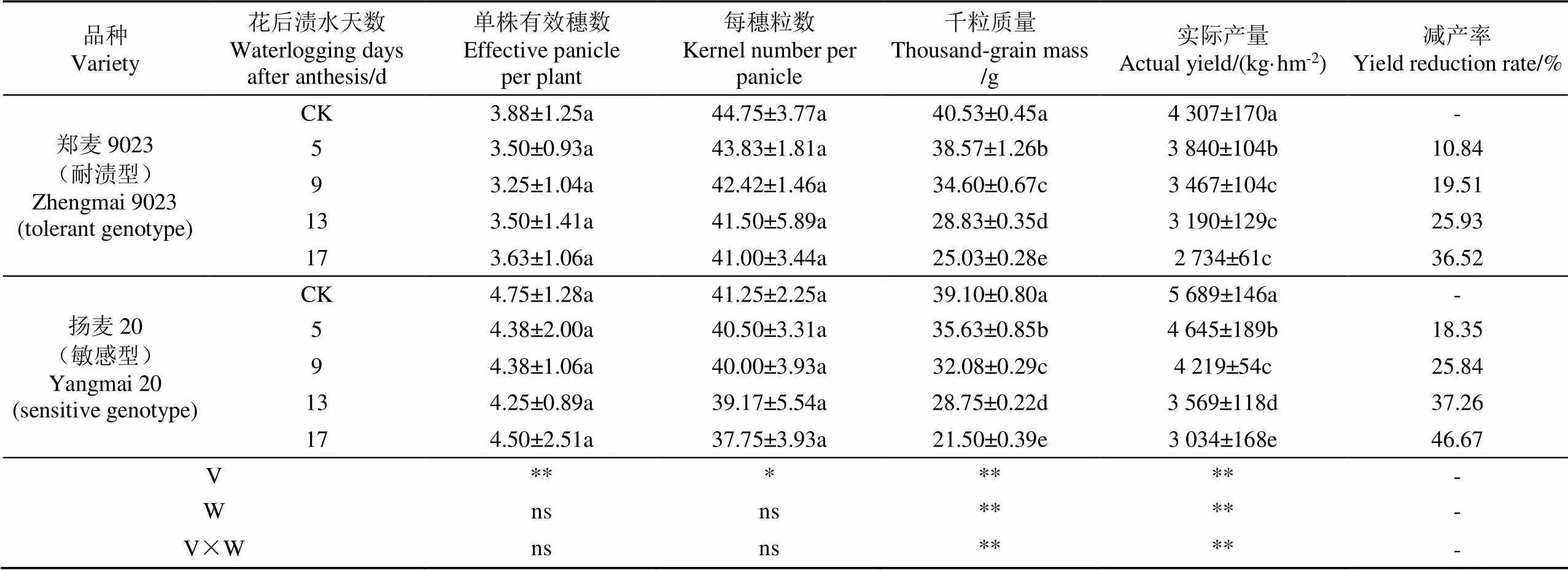
表1 花后渍水对冬小麦产量及其构成要素的影响
注:同列数值后不同字母表示同一品种不同处理间在<0.05水平上差异显著;*:<0.05;**:<0.01;ns:不显著,下同。V:品种;W:花后渍水天数。
Note: Different letters following the values within the same columns indicate significant differences among the different treatments for a variety at<0.05 level; *:<0.05; **:<0.01; ns: not significant, the same as below. V: variety; W: waterlogging days after anthesis.
2.2 Richards模型参数分析
利用Richards模型对冬小麦籽粒灌浆进程进行拟合,拟合方程参数及决定系数(2)如表2所示。由表2可知,各拟合方程的2均大于0.99,达到极显著水平(<0.01),表明用Richards方程模拟花后渍水冬小麦籽粒灌浆过程是合适的。最终籽粒质量(,g)随花后渍水天数的增加呈显著下降趋势(<0.05),与实测千粒质量的变化趋势一致,且与实测千粒质量的差值在0.14~2.80 g之间,表明用Richards模型拟合花后渍水冬小麦籽粒千粒质量动态过程是可行的。花后渍水处理>1(郑麦9023渍水5 d处理除外),说明花后渍水冬小麦千粒质量增长速率受库容限制较小,即灌浆物质来源相对匮乏,且渍水天数越长,灌浆物质来源越匮乏。
2.3 冬小麦灌浆特征参数分析
根据表2中Richards模型计算的冬小麦灌浆特征参数,结果如表3所示。对于郑麦9023(耐渍型),当花后渍水达到9 d时活跃灌浆期(,d)显著缩短(<0.05),最大灌浆速率出现时间(max,d)显著前移,其缩短了5.008 d,max提前了0.771 d;花后渍水5 d后单粒最大灌浆速率(max,mg/d)显著降低,但随着渍水天数延长,max无显著降低趋势,花后渍水13 d时单粒平均灌浆速率(ave,mg/d)才显著降低。因此,花后渍水导致耐渍型冬小麦降低的主要原因是活跃灌浆期缩短,最大灌浆速率出现时间前移。对于扬麦20(敏感型),花后渍水5 d其ave就显著下降(<0.05),到花后渍水9 d时其max亦显著下降,而花后渍水、max无规律性变化,表明花后渍水主要导致敏感型冬小麦灌浆速率降低,最终导致降低。

表2 花后渍水处理下冬小麦籽粒灌浆进程的Richards模型模拟结果
注::开花后天数,d;:对应的籽粒千粒质量,g。
Note:: waterlogging days after anthesis, d;: the thousand-grain mass corresponding to, g.

表3 不同渍水处理下冬小麦籽粒灌浆特征参数
对两个不同类型冬小麦的灌浆特征参数与渍水天数进行分析,结果如表4所示。由表4可知,郑麦9023(耐渍型)灌浆特征参数中与花后渍水天数(,d)呈极显著线性关系(<0.01),max、ave与花后渍水天数呈显著线性关系(<0.05),而max与花后渍水天数无显著线性关系;扬麦20(敏感型)灌浆特征参数中的max、ave与花后渍水天数呈极显著线性关系(<0.01),而、max与花后渍水天数无显著线性关系。从回归关系式得出:花后渍水天数每增加1 d,拟合郑麦9023(耐渍型)灌浆过程的Richards模型中的缩短0.827 d、max提前0.163 d、ave降低0.004 mg/d;拟合扬麦20(敏感型)灌浆过程的Richards模型中的max降低0.046 mg/d、ave降低0.032 mg/d。
2.4 冬小麦各灌浆阶段分析
根据表2中Richards模型计算冬小麦3阶段籽粒灌浆持续时间和单粒平均灌浆速率,结果如表5所示。未渍水时两个品种冬小麦的籽粒灌浆渐增期、快增期和缓增期灌浆进程就存在差异,郑麦9023(耐渍型)籽粒灌浆渐增期持续天数(1)较短,快增期持续天数(2)和缓增期持续天数(3)较长,2、3分别是1的2.09、2.93倍;而扬麦20(敏感型)的各时期持续天数基本相同,为12 d左右。花后渍水对郑麦9023(耐渍型)1、2、3有明显影响,花后渍水5 d时郑麦9023(耐渍型)1显著延长0.421 d(<0.05),2和3显著缩短0.510 d和1.952 d,2和3缩短天数之和超过了1延长天数,导致缩短;随着花后渍水天数持续增加,1不再显著延长,2和3仍呈显著缩短趋势。花后渍水条件下,扬麦20(敏感型)1、2、3变化无明显规律,而渐增期单粒平均灌浆速率(1)、快增期单粒平均灌浆速率(2)和缓增期单粒平均灌浆速率(3)随着渍水天数增加呈显著降低趋势(<0.05),而郑麦9023(耐渍型)在渍水条件下各灌浆阶段的灌浆速率与CK相比基本无差异,即各阶段灌浆速率受渍水影响不显著。对于耐渍型冬小麦,花后渍水主要显著缩短快增期和缓增期灌浆持续天数,最终导致活跃灌浆期天数显著缩短;对于敏感型冬小麦,花后渍水主要显著降低渐增期、快增期和缓增期灌浆速率,从而使整个灌浆期平均灌浆速率显著降低。
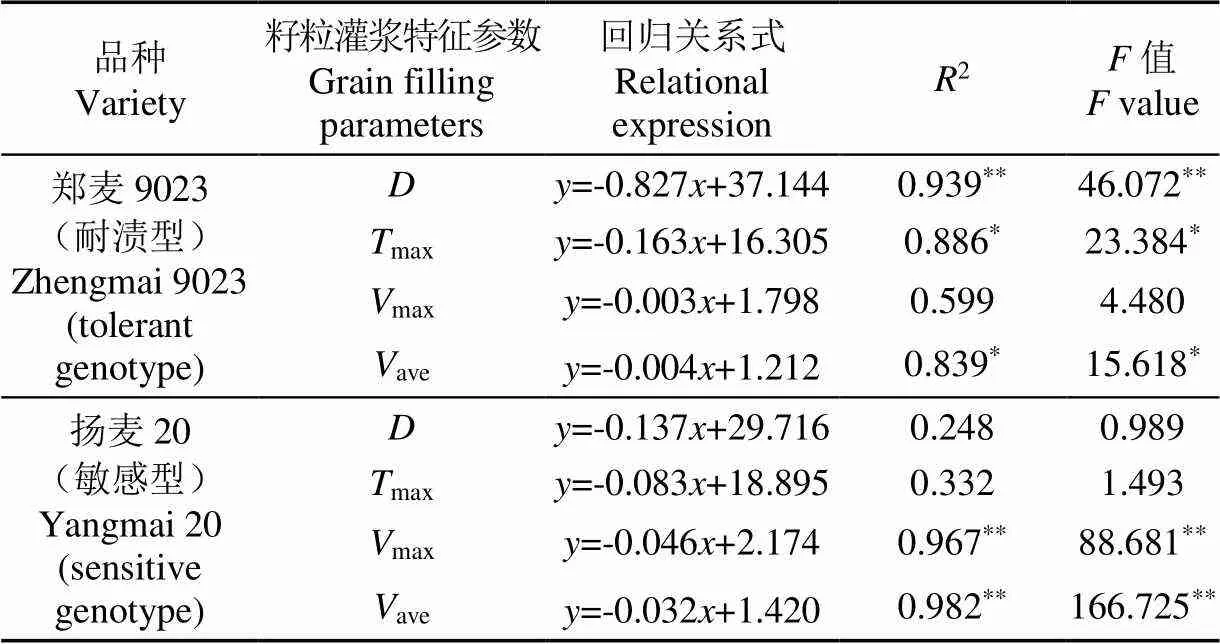
表4 籽粒灌浆特征参数与花后渍水天数回归分析
注::籽粒灌浆特征参数;:花后渍水天数,下同。
Note:: grain fillingcharacteristic parameters;: waterlogging days after anthesis, the same as below.
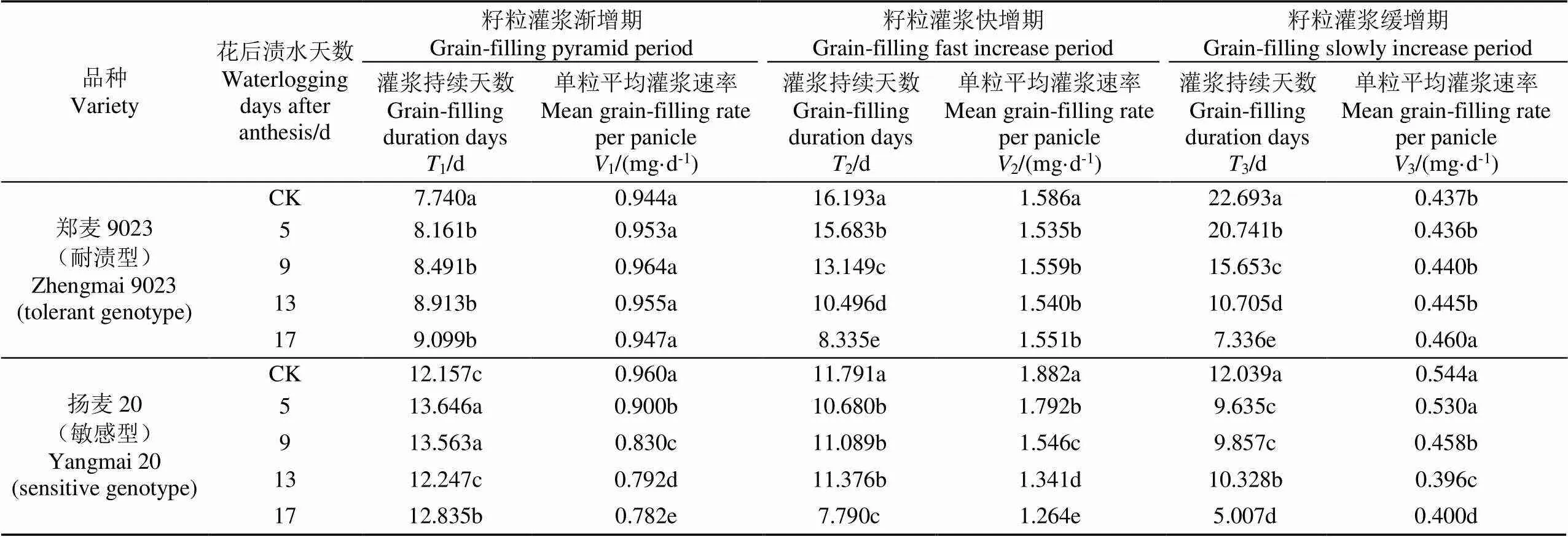
表5 不同渍水处理下冬小麦籽粒各阶段灌浆持续天数和灌浆速率
对两个品种冬小麦的各阶段籽粒灌浆特征参数与花后渍水天数进行分析,结果如表6所示。由表6可知,郑麦9023(耐渍型)1与花后渍水天数()呈极显著线性正相关(<0.01),2、3与花后渍水天数呈极显著线性负相关,而1、2、3与花后渍水天数无显著线性关系;扬麦20(敏感型)1、2与花后渍水时间呈极显著线性负相关(<0.01),3与花后渍水时间呈显著线性负相关(<0.05),而1、2、3与花后渍水天数无显著线性关系。从回归关系式得出,渍水增加1 d,郑麦9023(耐渍型)渐增期灌浆持续时间增加0.083 d,而快增期、缓增期灌浆持续时间分别减少0.492、0.963 d;扬麦20渐增期、快增期和缓增期单粒灌浆速率分别降低0.011、0.040和0.010 mg/d。
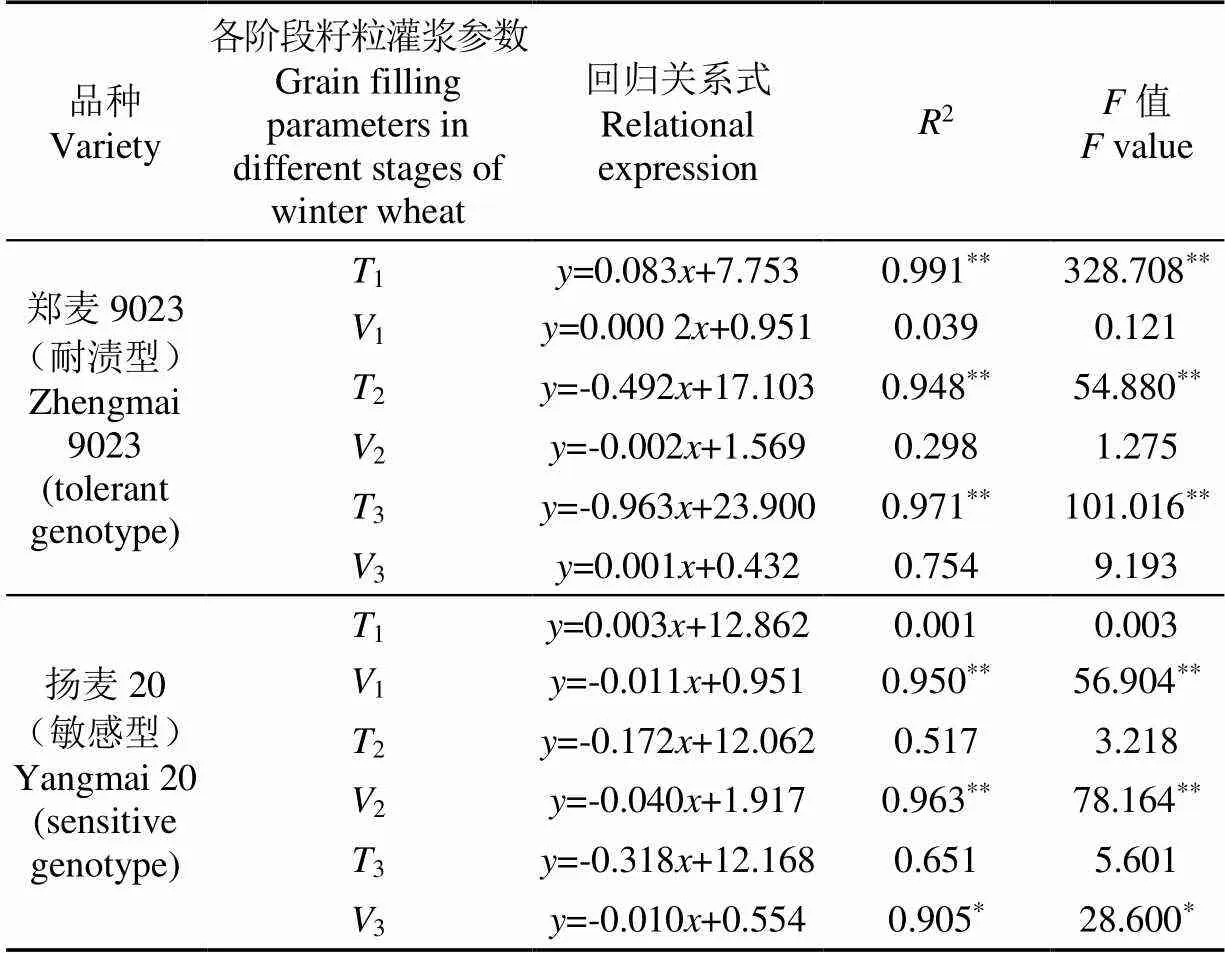
表6 各阶段籽粒灌浆参数与花后渍水天数回归分析
3 讨 论
冬小麦在不同生育期对渍水的敏感性不同,一般认为生殖生长阶段渍水胁迫对冬小麦的影响大于营养生长阶段,开花期前后是冬小麦对渍水最为敏感的时期[7-8]。花后渍水使冬小麦减产严重,吴启侠等[24]研究认为灌浆期渍涝5~15 d郑麦9023产量下降7.6%~43.7%;丁锦峰等[25]研究认为花后渍水5~15 d扬辐麦4号籽粒产量下降15%~34%;本研究表明花后渍水5~17 d郑麦9023减产10.84%~36.52%,扬麦20减产14.25%~47.84%(表 1),与之前研究得出的花后渍水使小麦产量下降幅度基本一致。Araki等[26-27]研究认为,花后渍水造成冬小麦产量下降的主要原因是千粒质量降低;丁锦峰等[25,28]研究认为,花后渍水显著减低穗粒数和千粒质量。虽然研究表述花后渍水造成产量下降的主要因素不尽一致,但均表明花后渍水造成冬小麦产量下降的主要因素之一是千粒质量显著下降。本试验结果表明,花后渍水使每穗粒数减少,但不是引起产量下降的主导因素,其主要因素是千粒质量下降,与大多数研究结果一致。
小麦产量的80%~90%来自花后光合产物[16],花后是冬小麦增加单粒质量,提高产量的关键生育期。大量研究表明冬小麦单粒质量主要受籽粒灌浆速率和持续时间影响,这两个性状既受品种遗传特性的影响,也受环境因素的影响。花后渍水主要是通过缩短灌浆周期,降低灌浆速率来降低千单粒质量,且不同基因型小麦间存在一定差异[29-30]。高温胁迫主要是通过降低灌浆速率来降低千单粒质量,且对籽粒灌浆快增期的影响最为重要[31]。严重缺水显著降低小麦籽粒灌浆速率,而适度干旱胁迫可促进小麦籽粒灌浆速率[32]。由此可见不同环境因素影响小麦单粒质量的因素具有差异化。本研究结果表明,花后渍水使冬小麦籽粒灌浆历时缩短,灌浆速率降低,最终导致千粒质量下降,产量降低。但不同基因型小麦间存在一定差异,花后渍水主要缩短耐渍型冬小麦活跃灌浆期天数,最大灌浆速率出现时间前移,花后渍水天数每增加1 d,缩短0.827 d、max提前0.163 d;而对于敏感型冬小麦主要是降低灌浆速率,花后渍水天数每增加1 d,max降低0.046 mg/d、ave降低0.032 mg/d(表4)。其可能与2个品种的遗传因素有关,郑麦9023单粒质量仅与籽粒灌浆持续期、平均灌浆速率和最大灌浆速率显著相关[33],而扬麦20千粒质量与最大灌浆速率、平均灌浆速率以及籽粒灌浆渐增期、快增期和缓增期的灌浆速率均呈极显著正相关,而与灌浆持续时间长短无显著性关系[34]。
小麦籽粒灌浆过程主要分为渐增期、快增期、缓增期,大量研究表明小麦灌浆籽粒的物质积累量主要集中在快增期[35-36],也有研究表明单粒质量与灌浆持续时间(有效灌浆期和活跃灌浆期)、尤其灌浆中后期(快增期和缓增期)呈显著正相关[33],总之小麦籽粒物质积累主要集中在快增期和缓增期。本研究得出,对于耐渍型冬小麦,花后渍水缩短快增期和缓增期灌浆持续时间;对于敏感型小麦,花后渍水降低其渐增期、快增期和缓增期灌浆速率,且对快增期灌浆速率的影响大于缓增期和渐增期,从而降低小麦籽粒的千粒质量,最终导致小麦减产。
4 结 论
1)花后渍水5、9、13和17 d郑麦9023(耐渍型)分别减产10.84%、19.51%、25.93%和36.52%,扬麦20(敏感型)分别减产14.25%、25.84%、37.26%和47.84%,减产的主要原因是千粒质量降低,花后渍水天数每增加1 d,冬小麦郑麦9023(耐渍型)和扬麦20(敏感型)千粒质量分别降低0.961和0.996 g。
2)对耐渍型冬小麦,花后渍水主要显著缩短灌浆持续时间,且主要是显著缩短籽粒灌浆快增期和缓增期的持续天数;对敏感型冬小麦,花后渍水显著降低籽粒灌浆三阶段的灌浆速率。
3)花后渍水增加1 d,郑麦9023籽粒活跃灌浆期缩短0.827 d,籽粒灌浆渐快增期、缓增期灌浆持续天数分别缩短0.492、0.963 d,扬麦20籽粒单粒最大灌浆速率降低0.046 mg/d、单粒平均灌浆速率降低0.032 mg/d,籽粒灌浆渐增期、快增期和缓增期单粒灌浆速率分别降低0.011、0.040和0.010 mg/d。
[1] 国家统计局. 中国统计年鉴2020[M]. 北京:中国统计出版社,2020.
[2] Yang H S, Zhai S L, Li Y F, et al. Waterlogging reduction and wheat yield increase through long-term ditch-buried straw return in a rice-wheat rotation system[J]. Field Crops Research, 2017, 209: 189-197.
[3] 柳道明,贾文婕,王小燕,等. 喷施外源6-BA对小麦孕穗期渍害的调控效应[J]. 作物杂志,2015(2):84-88.
Liu Daoming, Jia Wenjie, Wang Xiaoyan, et al. Effects of exogenous 6-BA on wheat with waterlogging at booting stage[J]. Crops, 2015(2): 84-88. (in Chinese with English abstract)
[4] 张佩,吴洪颜,江海东,等. 长江中下游油菜春季湿渍害灾损风险评估研究. 气象与环境科学,2019,42(1):11-17.
Zhang Pei, Wu Hongyan, Jiang Haidong, et al. Risk assessment study on rapeseed suffering from spring wet damages in the middle and lower reaches of Yangtze River[J]. Meteorological and Environmental Sciences, 2019, 42(1): 11-17. (in Chinese with English abstract)
[5] 王小燕,高春保,卢碧林,等. 江汉平原小麦开花前降水分布特点及同期渍害的产量效应[J]. 长江流域资源与环境,2013,22(12):1642-1647.
Wang Xiaoyan, Gao Chunbao, Lu Bilin, et al. Characteristics of rainfall before anthesis and corresponding effects of waterlogging on grain yield in Jianghan plain[J]. Resources and Environment in the Yangtze Basin, 2013, 22(12): 1642-1647. (in Chinese with English abstract)
[6] 吴洪颜,张佩,徐敏,等. 长江中下游地区冬小麦春季涝渍害灾损风险时空分布特征[J]. 长江流域资源与环境,2018,27(5):1152-1158.
Wu Hongyan, Zhang Pei, Xu min, et al. Spatial-temporal variations of the risk of winter wheat loss suffered from spring waterlogging disaster in the middle and lower Yangtze River reaches[J]. Resources and Environment in the Yangtze Basin, 2018, 27(5): 1152-1158. (in Chinese with English abstract)
[7] Shao G C, Lan J J, Yu S E, et al. Photosynthesis and growth of winter wheat in response to waterlogging at different growth stages[J]. Photosynthetica, 2013, 51(3): 429-437.
[8] Romina P, Abeledo L G, Miralles D J. Physiological traits associated with reductions in grain number in wheat and barley under waterlogging[J]. Plant and Soil, 2018, 429: 469-481.
[9] Tan W, Liu J, Dai T, et al. Alterations in photosynthesis and antioxidant enzyme activity in winter wheat subjected to post-anthesis waterlogging[J]. Photosynthetica, 2008, 46(1): 21-27
[10] 向永玲,方正武,赵记伍,等. 灌浆期涝渍害对弱筋小麦籽粒产量及品质的影响[J]. 麦类作物学报,2020,40(6):730-736.
Xiang Yongling, Fang Zhengwu, Zhao Jiwu, et al. Effect of waterlogging at grain filling stage on grain yield and quality of weak gluten wheat[J]. Journal of Triticeae Crops, 2020, 40(6): 730-736. (in Chinese with English abstract)
[11] Yan S C, Wu Y, Fan J L, et al. Effects of water and fertilizer management on grain filling characteristics, grain weight and productivity of drip-fertigated winter wheat[J]. Agricultural Water Management, 2019, 213: 983-995.
[12] Kumar A, Yadav R, Gupta S, et al. Identification of genotypes and marker validation for grain filling rate and grain filling duration in wheat under conservation agriculture[J]. Indian Journal of Genetics and Plant Breeding, 2018, 78(3): 309-316.
[13] Yadav G, Ellis R H. Effects of rain shelter or simulated rain during grain filling and maturation on subsequent wheat grain quality in the UK[J]. Journal of Agricultural Science, 2016, 155(2): 300-316.
[14] Thapa S, Jessup K E, Pradhan G P, et al. Canopy temperature depression at grain filling correlates to winter wheat yield in the U. S. Southern High Plains[J]. Field Crops Research, 2018, 217: 11-19.
[15] Tian L, Bi W, Liu X, et al. Effects of waterlogging stress on the physiological response and grain-filling characteristics of spring maize (L.) under field conditions[J]. Acta Physiologiae Plantarum, 2019, 41(5): 63-77.
[16] 杨丽丽,任建宏,刘溢建,等. 小麦花后水分亏缺和复水对同化物转运和籽粒灌浆的影响[J]. 西北植物学报,2020,40(11):1909-1911.
Yang Lili, Ren Jianhong, Liu Yijian, et al. Effect of water deficit and rehydration on the post-flowering assimilate transport and grain filling in wheat[J]. Acta Botanica Boreali Occidentalia Sinica. 2020, 40(11): 1909-1911. (in Chinese with English abstract)
[17] 徐云姬,许阳东,李银银,等. 干湿交替灌溉对水稻花后同化物转运和籽粒灌浆的影响[J]. 作物学报,2018,44(4):544-568.
Xu Yunji, Xu Yangdong, Li Yinyin, et al. Effect of alternate wetting and drying irrigation on post-anthesis remobilization of assimilates and grain filling of rice[J]. Acta Agronomica Sinica, 2018, 44(4): 554-568. (in Chinese with English abstract)
[18] 苗永杰,阎俊,赵德辉,等. 黄淮麦区小麦主栽品种粒重与籽粒灌浆特性的关系[J]. 作物学报,2018,44(2):260-267.
Miao Yongjie, Yan Jun, Zhao Dehui, et al. Relationship between grain filling parameters and grain weight in leading wheat cultivars in the Yellow and Huai Rivers Valley[J]. Acta Agronomica Sinica, 2018, 44(2): 260-267. (in Chinese with English abstract)
[19] 薛香,吴玉娥,陈荣江,等. 小麦籽粒灌浆过程的不同数学模型模拟比较[J]. 麦类作物学报,2006,26(6):169-171.
Xue Xiang, Wu Yu′e, Chen Rongjiang, et al. Comparison of different mathematical equations for simulating the grain filling process of wheat[J]. Journal of Triticeae Crops, 2006, 26(6): 169-171. (in Chinese with English abstract)
[20] 姚素梅,康跃虎,吕国华,等. 喷灌与地面灌溉条件下冬小麦籽粒灌浆过程特性分析[J]. 农业工程学报,2011,27(7):13-17.
Yao Sumei, Kang Yuehu, Lü Guohua, et al. Analysis on grain filling characteristics of winter wheat under sprinkler irrigation and surface irrigation conditions[J]. Transactions of the Chinese Society of Agricultural Engineering (Transactions of the CSAE), 2011, 27(7): 13-17. (in Chinese with English abstract)
[21] 于晶晶,王小燕,段营营,等. 江汉平原主推小麦品种抗渍能力研究[J]. 湖北农业科学,2014,53(4),760.
Yu Jingjing, Wang Xiaoyan, Duan Yingying, et al. Studies on the waterlogging resistance of main wheat varieties in Jianghan Plain[J]. Hubei Agricultural Sciences, 2014, 53(4), 760. (in Chinese with English abstract)
[22] 朱庆森,曹显祖,骆亦其. 水稻籽粒灌浆的生长分析[J]. 作物学报,1988(3):182-193.
Zhu Qingsen, Cao Xianzu, Luo Yiqi. Growth analysis on the process of grain filling in rice[J]. Acta Agronomica Sinica, 1988(3): 182-193. (in Chinese with English abstract)
[23] 孟兆江,孙景生,段爱旺,等. 调亏灌溉条件下冬小麦籽粒灌浆特征及其模拟模型[J]. 农业工程学报,2010,26(1):18-23. Meng Zhaojiang, Sun Jingsheng, Duan Aiwang, et al. Grain filling characteristics of winter wheat with regulated deficit irrigation and its simulation models[J]. Transactions of the Chinese Society of Agricultural Engineering (Transactions of the CSAE), 2010, 26(1): 18-23. (in Chinese with English abstract)
[24] 吴启侠,朱建强,杨威,等. 小麦对渍涝的响应及排水指标确定[J]. 农业工程学报,2014,30(16):91-98.
Wu Qixia, Zhu Jianqiang, Yang Wei, et al. Response of wheat to waterlogging and determination of drainage index[J]. Transactions of the Chinese Society of Agricultural Engineering (Transactions of the CSAE), 2014, 30(16): 91-98. (in Chinese with English abstract)
[25] 丁锦峰,苏盛楠,梁鹏,等. 拔节期和花后渍水对小麦产量、干物质及氮素积累和转运的影响[J]. 麦类作物学报,2017,37(11):1473-1479.
Ding Jingfeng, Su Shengnan, Liang Peng, et al. Effect of waterlogging at elongation or after anthesis on grain yield and accumulation and remobilization of dry matter and nitrogen in wheat[J]. Journal of Triticeae Crops, 2017, 37(11): 1473-1479. (in Chinese with English abstract)
[26] Araki H, Hamada A, Hossain M A, et al. Waterlogging at jointing and/or after anthesis in wheat induces early leaf senescence and impairs grain filling[J]. Field Crops Research, 2012, 137: 27-36.
[27] Hossain M A, Araki H, Takahashi T. Poor grain filling induced by waterlogging is similar to that in abnormal early ripening in wheat in Western Japan[J]. Field Crops Research, 2011, 123(2): 100-108.
[28] 吴启侠,朱建强,程伦国,等. 基于地下水埋深的江汉平原冬小麦防涝渍排水指标确定[J]. 农业工程学报,2017,33(3):121-127.
Wu Qixia, Zhu Jianqiang, Chen Lunguo, et al. Determination of groundwater depth-based drainage index against waterlogging and submergence for winter wheat in Jianghan Plain[J]. Transactions of the Chinese Society of Agricultural Engineering (Transactions of the CSAE), 2017, 33(3): 121-127. (in Chinese with English abstract)
[29] 武文明,陈洪俭,李金才,等. 氮肥运筹对孕穗期受渍冬小麦旗叶叶绿素荧光与籽粒灌浆特性的影响[J]. 作物学报,2012,38(6):1088-1096.
Wu Wenming, Chen Hongjian, Li Jincai, et al. Effects of nitrogen fertilization on chlorophyll fluorescence parameters of flag leaf and grain filling in winter wheat suffered waterlogging at booting stage[J]. Acta Agronomica Sinica 2012, 38(6): 1088-1096. (in Chinese with English abstract)
[30] 范雪梅,姜东,戴廷波,等. 花后干旱或渍水下氮素供应对小麦光合和籽粒淀粉积累的影响[J]. 应用生态学报,2005,16(10):1883-1888.
Fan Xuemei, Jiang Dong, Dai Tingbo, et al. Effects of nitrogen supply on flag leaf photosynthesis and grain starch accumulation of wheat from its anthesis to maturity under drought or waterlogging[J]. Chinese Journal of Applied Ecology, 2005, 16(10): 1883-1888. (in Chinese with English abstract)
[31] 苗永杰. 高温胁迫对小麦籽粒灌浆特性及主要品质性状的影响[D]. 北京:中国农业科学院,2016.
Miao Yongjie. Effect of Wheat Stress on Grain Filling and Major Quality Traits of Common Wheat[D]. Beijing: Chinese Academy of Agricultural Sciences Dissertation, 2016. (in Chinese with English abstract)
[32] 梁海燕,刘迪迪,张娜,等. 干旱胁迫对不同基因型小麦籽粒灌浆及内源激素的影响[J]. 西北农业学报,2015,24(5):41-47.
Liang Haiyan, Liu Didi, Zhang Na, et al. Effect of water stress on grain filling and endogenous hormone changes in wheat grains of different genotypes[J]. Acta Agriculturae Boreali-occidentalis Sinica, 2015, 24(5): 41-47. (in Chinese with English abstract)
[33] 马新明,张娟娟,熊淑萍,等. 氮肥用量对不同品质类型小麦品种籽粒灌浆特征和产量的影响[J]. 麦类作物学报,2005,25(6):72-77.
Ma Xinming, Zhang Juanjuan, Xiong Shuping, et al. Effect of different amounts of nitrogen application on grain filling and yield of wheat varieties with different qualities[J]. Journal of Triticeae Crops, 2005, 25(6): 72-77. (in Chinese with English abstract)
[34] 朱冬梅,王慧,刘大同,等. 小麦籽粒灌浆与脱水特性[J]. 中国农业科学,2019,52(23):4251-4261.
Zhu Dongmei, Wang Hui, Liu Datong, et al. Characteristics of grain filling and dehydration in wheat[J]. Scientia Agricultura Sinica, 2019, 52(23): 4251-4261. (in Chinese with English abstract)
[35] 杨金宇,李援农,王凯瑜,等. 控释氮肥与普通尿素配施比例和方法对冬小麦灌浆特性的影响[J]. 植物营养与肥料学报,2020,26(3):442-452.
Yang Jinyu, Li Yuannong, Wang Kaiyu, et al. Effects of blending ratio and application method of controlled-release nitrogen fertilizer and common urea on grain-filling properties of winter wheat[J]. Journal of Plant Nutrition and Fertilizers, 2020, 26(3): 442-452. (in Chinese with English abstract)
[36] 赵凯男,常旭虹,张赵星,等. 地膜覆盖对小麦土壤水热状况及灌浆特性的影响[J]. 麦类作物学报,2018,38(10):1237-1245.
Zhao Kainan, Chang Xuhong, Zhang Zhaoxing, et al. Effect of mulching on the moisture and temperature of soil and grain-filling characteristics of wheat[J]. Journal of Triticeae Crops, 2018, 38(10): 1237-1245. (in Chinese with English abstract)
Effects of waterlogging after anthesis on the grain filling characteristics of winter wheat with different waterlogging tolerances
Wu Qixia1,2, Tan Jinghong1,2, Zhu Jianqiang1,2, Wang Wei1,2, Han Rui1,2, Zou Juan3※
(1.,,434025,;2.,,434025,; 3.,,430064,)
Frequent occurrence of waterlogging has posed a great threat to the production of the crops in the middle and late stages of winter wheat growth in the Jianghan Plain, even the middle and lower reaches of the Yangtze River in China. However, the impact of waterlogging on the grain filling process is still unclear during this time. Taking Zhengmai 9023 (tolerant genotype) and Yangmai 20 (sensitive genotype) as research objects, this study aims to explore the effects of water logging after anthesis on grain filling of winter wheat under different tolerances. A systematic experiment was conducted under 5, 9, 13, and 17 d of waterlogging duration after anthesis of winter wheat in the test-pit with a controllable irrigation and drainage system. The soil moisture was kept at 90% field capacity in the waterlogging treatments. Meanwhile, the treatment with soil moisture at 70%-80% field capacity was used as a control. The grain filling was firstly simulated for two varieties of wheat under waterlogging environment stress using the Richard model. Subsequently, the yield component parameters were quantitatively analyzed the dynamic influence on grain filling, further to explore the influence process after anthesis waterlogging on winter wheat yield. The results showed that the waterlogging for 5, 9, 13, and 17 d after anthesis reduced the yield of Zhengmai 9023 (tolerant genotype) by 10.84%, 19.51%, 25.93%, 36.52% and Yangmai 20 (sensitive genotype) by 14.25%, 25.84%, 37.26%, 47.84%, respectively. The main reason was attributed to the decrease of thousand-grain mass. When waterlogging increased by 1 d after anthesis, the thousand-grain mass of Zhengmai 9023 (tolerance genotype) and Yangmai 20 (sensitive genotype) decreased by 0.961 and 0.996 g, respectively. The Richards equation presented better to simulate the grain filling of waterlogged winter wheat after anthesis. Specifically, the determination coefficients of the fitting equation were all above 0.99. Furthermore, there was a different influence mechanism of waterlogging after anthesis on the grain filling of wheat under different waterlogging tolerance. In waterlogging-tolerant wheat, the waterlogging was greatly contributed to shortening significantly the active days of the grain filling after anthesis, and specially shortened significantly the duration days in grain-filling fast increase period and grain-filling slowly increase period. In the waterlogging-sensitive wheat, the waterlogging after anthesis was mainly contributed to significantly reducing the filling rate in three periods of grain filling. Specifically, the waterlogging increased by 1 d after anthesis, and the grain filling active days of Zhengmai 9023 was shortened by 0.827 d, among which the duration days in grain-filling fast increase period and grain-filling slowly increase period was shortened by 0.492 and 0.963 d, respectively. Correspondingly, waterlogging increased by 1 d after anthesis, the maximum grain-filling rate per kernel of Yangmai 20 decreased by 0.046 mg/d, and the mean grain-filling rate per kernel decreased by 0.032 mg/d, the grain-filling rate per kernel in grain-filling pyramid period, grain-filling fast increase period and grain-filling slowly increase the period of winter wheat decreased by 0.011, 0.040 and 0.010 mg/d, respectively. The finding can provide strong theoretical support for the prevention and control of waterlogging disasters in winter wheat.
irrigation; yield; waterlogging stress; Richards model; grain-filling characteristic parameters; winter wheat
吴启侠,谭京红,朱建强,等. 花后渍水对不同耐渍型冬小麦籽粒灌浆特性的影响[J]. 农业工程学报,2021,37(18):74-81.doi:10.11975/j.issn.1002-6819.2021.18.009 http://www.tcsae.org
Wu Qixia, Tan Jinghong, Zhu Jianqiang, et al. Effects of waterlogging after anthesis on the grain filling characteristics of winter wheat with different waterlogging tolerances[J].Transactions of the Chinese Society of Agricultural Engineering (Transactions of the CSAE), 2021, 37(18): 74-81. (in Chinese with English abstract) doi:10.11975/j.issn.1002-6819.2021.18.009 http://www.tcsae.org
2020-10-04
2021-09-06
国家重点研发计划(2016YFD0300405);湿地生态与农业利用教育部工程研究中心开放基金(KFT201906);公益性行业(农业)科研专项(201203032)
吴启侠,博士,高级实验师,研究方向为作物生产水土环境调控。Email:qixiawu@yangtzeu.edu.cn
邹娟,博士,副研究员,研究方向为小麦丰产抗逆栽培。Email:zoujuan1010@163.com
10.11975/j.issn.1002-6819.2021.18.009
S275
A
1002-6819(2021)-18-0074-08

